To remain competitive, modern businesses need to constantly adhere to high standards and keep up with the times. While traditional inspection methods can be time-consuming and prone to human error, anomaly detection with computer vision (CV) can transform quality control processes across industries.
This article explains how computer vision solutions development works for anomaly detection, its benefits, implementation challenges, and why you should develop your CV solution with CHI Software.
Article Highlights
- Combining unsupervised and self-supervised machine learning improves the detection of potential defects and trains AI models on large amounts of data.
- Machine learning and computer vision can incorporate information from extensive data sets, enabling predictive maintenance and better decision-making.
- The hail damage scanning system for vehicles developed by CHI Software is a prime example of how a CV solution can be successfully integrated into an existing ecosystem to bring significant benefits.
Mechanism of Computer Vision in Anomaly Detection
To understand how computer vision is used for anomaly detection, you need to be familiar with its workflow, so here it is.
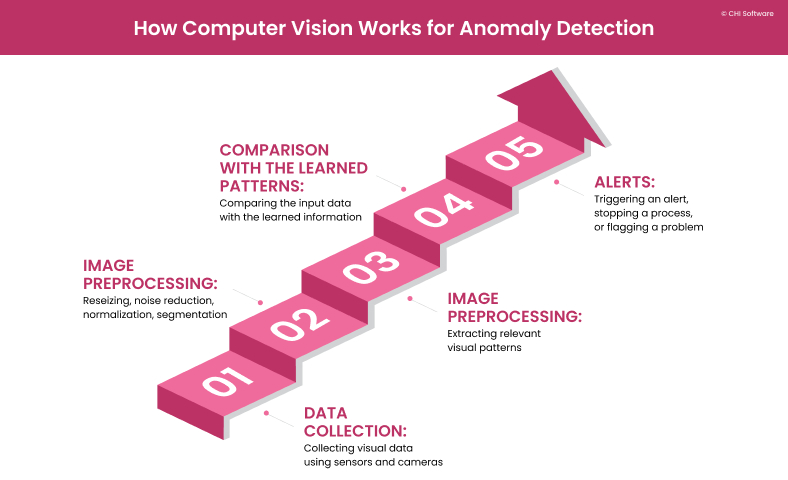
A step-by-step flow of CV solutions for anomaly detection
1. Data collection: The first step is to collect visual data, usually using cameras or sensors.
2. Image preprocessing: Raw datasets often require preparations to make them suitable for anomaly detection using computer vision. This stage can include:
- resizing original images or videos;
- filtering out unimportant or distracting elements (noise reduction);
- adjusting pixel values (normalization);
- focusing on the area of interest (segmentation).
3. Feature extraction: The system extracts relevant features or patterns from the images that reflect the objects’ normal appearance or behavior.
4. Comparison with learned patterns: Machine learning models previously trained on standard datasets compare the input data with the learned patterns. Any deviation from the normal range is then marked as an anomaly.
5. Alert: When an anomaly is detected, the CV system can trigger an alert, stop the process, or flag the problem for further human review.
Understanding Unsupervised and Self-Supervised Learning: Core Differences and Practical Use
Computer vision-based anomaly detection systems must be continuously trained to achieve the best results. That’s where machine learning algorithms come in – they help make sure the system is always being trained and improved. The following chapter will compare two machine learning methods and describe their differences.
| Aspect |
Unsupervised Learning |
Self-Supervised Learning |
| Labels |
No labeled data is used |
Self-generated labels from the data itself |
| Tasks |
Can find hidden structure, clusters, or anomalies and group them |
Can learn from proxy tasks to generate useful representations |
| Goal |
Understanding data architecture without supervision |
Pretraining a model to learn features for future tasks |
| Quality Control Usage |
Detecting defects without prior labeling |
Pretraining models for defect detection |
Unsupervised Learning
Unsupervised learning means training your model on data that does not have labeled outcomes or predefined categories. In other words, unsupervised learning models analyze the input data and attempt to group it based on similarities.
Unsupervised learning is ideal for automated defect detection because this method does not require previous examples of defects. The model can learn what constitutes a ‘normal’ product by analyzing examples of products without defects, and flag new products that deviate from the norm.
Computer Vision for Quality Inspection: Boosting Accuracy and Efficiency
Read more
Self-Supervised Learning (SSL)
Self-supervised learning is a subset of unsupervised learning that generates labels based on input data. This method generates training tasks from an unlabelled dataset by creating proxy tasks (often called ‘drive tasks’).
This method allows the system to pre-train a large amount of unlabelled data, create its own synthetic library, and then transfer the knowledge to a specific quality inspection task.
Practical Tips
To get the best results from using unsupervised learning and self-directed learning, we recommend the following tips.
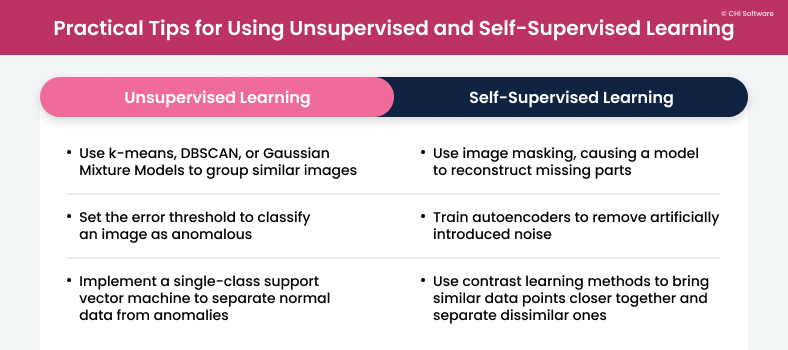
Recommendations from the CHI Software team on using unsupervised and self-supervised learning for your CV solution
Unsupervised learning:
- Use algorithms like k-means, DBSCAN, or Gaussian Mixture Models (GMM) to group similar images (normal data). These methods help the system recognize patterns in the average data, making it quicker to spot anomalies;
- Define a limit for how much error is acceptable when trying to reconstruct an image. If an image’s reconstruction error goes beyond that threshold, it can be flagged as an anomaly;
- Apply a single-class Support Vector Machine (SVM). This helps define the boundaries around your normal data and effectively separates any anomalies from what’s typical.
Self-supervised learning:
- Image masking is a significant technique in anomaly detection. Masking a part of the image causes the model to reconstruct the missing parts. In other words, imagine covering part of an image and asking a model to guess what’s missing. For normal data, the model fills in the gaps. But when there’s something unusual, it struggles to reconstruct the image correctly, signaling that something’s off;
- Train autoencoders to recover standard data by teaching them to remove artificially introduced noise. When you feed the model normal data with some added noise, it can restore it pretty well. But when an anomaly comes in, the model can’t clean it up as effectively, flagging it as something unusual;
- Use contrast learning methods (SimCLR or MoCo). Their aim is to bring similar (normal) data points closer together and separate dissimilar (potentially anomalous) data points.
Need experienced engineers to implement these tips? No problem – we've got you covered.
Leave us a message
Anomaly Detection with Computer Vision: Benefits and Common Challenges
In this section, we’ll look at the key benefits and challenges associated with implementing anomaly detection with AI based on practical experience.
Benefits of AI Anomaly Detection
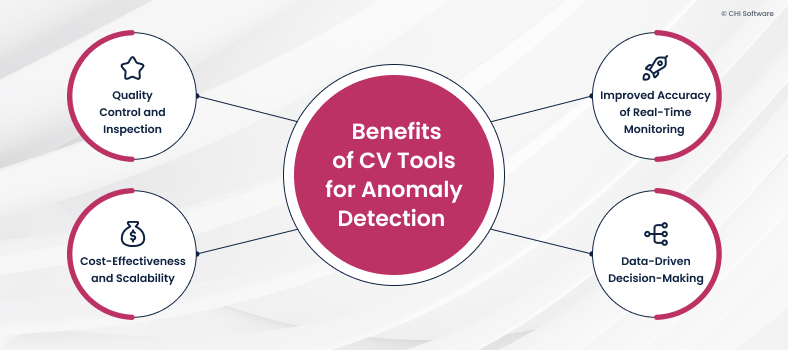
What business advantages CV-based anomaly detection can offer
- Automated quality control and inspection
AI-assisted anomaly detection significantly reduces reliance on manual inspections and provides greater accuracy in detecting defects. A great example is the vehicle hail damage scanning system enhanced by CHI Software.
Typically, assessing vehicles for hail damage is a time-consuming and imprecise process. CHI Software’s solution uses computer vision to quickly scan vehicles and automatically detect even the slightest signs of damage without human involvement. This approach increases the inspection’s speed and efficiency and ensures quality consistency by reducing human error.
- Cost-effectiveness and scalability
Computer vision software development can significantly reduce costs by automating inspection tasks. Once implemented, CV systems can be scaled to handle any production volume.
- Improved accuracy of real-time monitoring
Computer vision systems provide real-time anomaly detection to identify and resolve problems during production immediately.
Artificial Intelligence (AI) and the Evolution of Car Inspections
Read more
- Data-driven decision-making
With machine learning and image recognition solutions development, companies have access to a wealth of data that has been collected and already analyzed. Automated data collecting and analyzing empowers businesses to perform predictive maintenance, optimize processes, and make better strategic decisions based on the detected patterns.
By applying AI to detect anomalies, companies can take a proactive approach and increase efficiency and profitability. We can cite our article about machine learning in the healthcare industry to give an idea of the changes that a combination of CV and ML can bring. The mechanisms can analyze patient records and medical images to predict the likelihood of conditions or diseases. This approach can significantly speed up and improve decision-making, even when it comes to human health.
Common Challenges in Anomaly Detection with Computer Vision Technologies
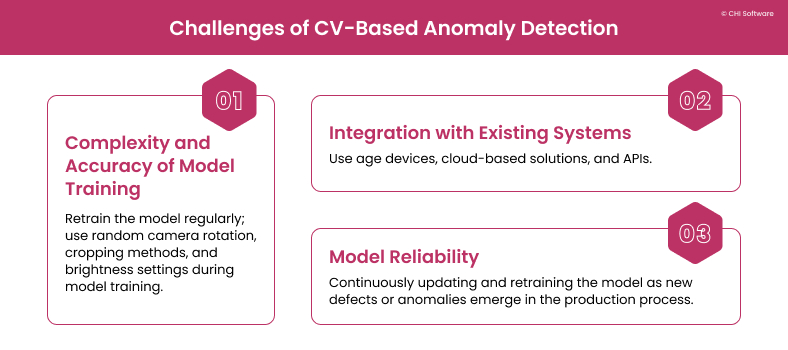
Challenges of CV-based anomaly detection and how to overcome them
- Complexity and accuracy of model training
Tuning fault models to ensure accuracy under different conditions and on various production lines is challenging. For example, variations in lighting, camera angles, and product positioning can affect detection performance, requiring continuous adjustments.
There are some practical tips for dealing with these issues. First of all, the data must be constantly updated. Developers can use random camera rotations, cropping methods, and brightness settings during model training. The team can also start using pre-trained models like ResNet and VGG. These models can be trained on specific data to improve anomaly detection performance under different conditions.
Another key to success is regular retraining. The models should be fed with updated data to capture even minor changes, so implementing a scheduled retraining process will help ensure that the model adapts over time.
From Generic to Specific: The Art of Training GPT to Suit Your Business
Read more
- Integration with existing systems
Companies must ensure compatibility with existing systems that may not be designed to handle the large amounts of image data required for computer vision applications. Here’s how you can address the challenge:
- Using edge computing devices, such as NVIDIA Jetson or Google Coral, allows you to process images directly at the source, reducing the need to send large amounts of image data over networks.
- For larger operations, consider using cloud-based solutions. They can handle large amounts of data, while the peripherals manage it locally.
- Think of APIs (application programming interfaces) as connectors that let your anomaly detection model communicate with other systems seamlessly. They can send sensor data to your model and return the results, all without needing to rewrite the whole system.
- Model reliability
A common problem with computer vision-driven anomaly detection is the occurrence of false positives – cases where standard products are falsely labeled as defective. This issue can lead to interruptions in production, which affects efficiency.
To solve this problem, consider continuously updating and retraining the model as new defects or anomalies emerge in the production process.
Key Ideas for Scaling Anomaly Detection Across Different Industries
Because computer vision offers innovative ways to automate quality control, operations monitoring, and decision-making across industries, we offer practical ideas for implementing anomaly detection in various sectors.
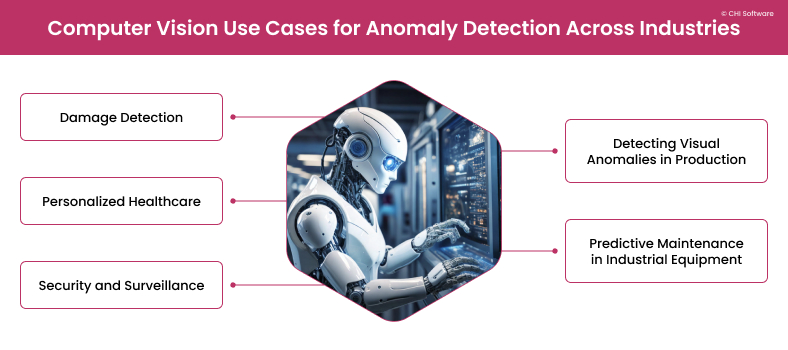
Industries that can benefit the most from CV-based anomaly detection
Damage Detection
A prime example of computer vision for damage detection is the vehicle hail scanning system developed by CHI Software. Our Solution uses advanced computer vision and deep learning for visual anomaly detection to detect any hail damage, including minor scratches, within approximately one minute.
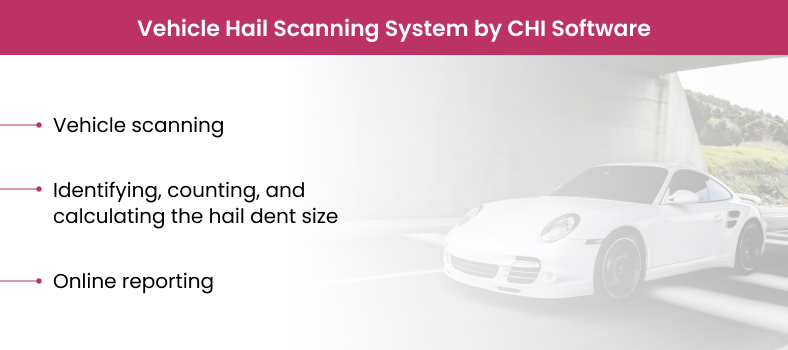
Our experience in building a damage detection solution for the automotive industry
This hail damage scanning solution is enabling our client from the Netherlands to provide new services at their stations like determining the exact level of damage my scanning the surface of the vehicle.
Detecting Visual Anomalies in Production
Integrating artificial intelligence and deep learning into production lines can improve quality control by detecting defects or production inconsistencies early. Such preventative measures reduce reject rates, ensure customer satisfaction, and help businesses in highly regulated industries like electronics or pharmaceuticals remain competitive.
Predictive Maintenance in Industrial Equipment
Predictive maintenance using anomaly detection in networks and sensors allows you to monitor the condition of industrial equipment. This approach can extend equipment life, reduce downtime, and optimize maintenance schedules in manufacturing and logistics.
Personalized Healthcare
By automating the analysis process, hospitals can reduce the number of diagnostic errors and speed up patient treatment. Additionally, anomaly detection systems help personalize treatment plans by tailoring medical solutions based on a patient’s individual data.
CHI Software’s experience developing machine learning solutions in healthcare demonstrates how data-driven solutions save lives – using models that can predict treatment outcomes, detect diseases at early stages, and optimize treatment pathways.
Security and Surveillance
Anomaly detection using computer vision can automatically monitor CCTV footage to detect unusual activity or behavior in public places, offices, or high-risk facilities. This approach can play a crucial role in preventing incidents before they escalate, increasing public safety and asset protection.
Check out some real-world examples of successful AI implementation in various industries.
Read our case studies
Ensuring Success: How CHI Software Delivers Computer Vision Solutions
But how do you get a computer vision solution tailored specifically for your business?
That’s where CHI Software comes in. Our step-by-step approach ensures you get a solution that’s not just powerful enough, but a perfect fit for what you need.
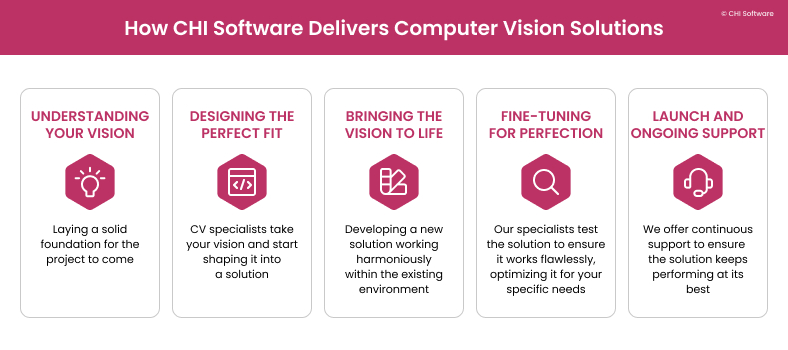
How our fundamental workflow looks in terms of computer vision development
Step 1: Understanding Your Vision
Before building the solution, it all starts with a conversation. This is where CHI Software’s team of experts will take the time to understand your business, pain points, and goals.
This is also the stage where we analyze your industry, market, and current setup to propose the right options. We evaluate the project’s technical feasibility and draw up a detailed project plan, accounting for timelines, resources required, and cost estimates.
Suppose you are interested in how the cost of software development is calculated – then check out our guidelines for software development cost estimation to find out!
Step 2: Designing the Perfect Fit
After understanding your goals, CHI Software’s team moves on to the design phase. A team of computer vision specialists takes your vision and starts shaping it into a solution.
Developers may create prototypes or proof of concepts (POC) at this stage, allowing you to see a draft of the solution before full-scale development begins.
Step 3: Bringing the Vision to Life
This is the stage where everything starts coming together. After the design has been finalized, CHI Software’s team begins the development process. Moreover, our developers ensure the new solution works harmoniously within your existing environment.
Step 4: Fine-Tuning
Once a solution has been built and integrated, our specialists test it to ensure it works flawlessly. This stage involves running the system through real-world scenarios to iron out any kinks and optimize performance.
Perhaps the solution needs to be tweaked to recognize objects faster, or perhaps it needs to be fine-tuned to work in low-light environments. Whatever the challenge, work in this stage ensures the final product is not only functioning but optimized for your specific needs.
Step 5: Launch and Ongoing Support
Even after the system goes live, CHI Software stays by your side. We offer continuous support to ensure the solution keeps performing at its best. Plus, as technology evolves, so can your system. CHI Software is there to help you scale or enhance your solution as your business grows and your needs change.
Conclusion
Organizations looking to stay competitive should consider investing in anomaly detection using ML and computer vision. These innovations have the potential to revolutionize quality control, no matter the industry.
To implement AI-based anomaly detection in your business, you need to choose a reliable partner with years of experience – one who knows all the ins and outs of developing and implementing solutions. We are confident that our team will be able to help you with this! Share your ideas now, and someone from our team will get back to you right away.
FAQs
-
How accurate is computer vision in detecting anomalies?

The accuracy of computer vision in detecting anomalies can vary depending on several factors, including:
- the quality of the training data,
- algorithms used,
- сontext-specific performance.
Considering these facts, CV systems for defect detection usually achieve 85% to 98% accuracy.
-
What industries benefit most from anomaly detection?

Here are some of the industries that benefit most from СV-powered anomaly detection:
- Manufacturing: CV is used for preventive maintenance and quality control of equipment or products.
- Healthcare: CV-powered systems can detect abnormalities in medical images or vital signs, helping in the early diagnosis of such diseases.
- Logistics: CV and AI-based solutions help monitor vehicle performance and can detect potential problems before they lead to breakdowns.
- Retail: Anomaly detection is helpful for inventory management or product quality checks.
-
How long does it take to implement an anomaly detection system?

The time required to implement an anomaly detection system can vary depending on several stages:
1. Initial assessment and requirements gathering typically takes one to four weeks;
2. Data preparation and cleaning can take a few days to several weeks, depending on the quality and volume of data available;
3. Model's development and training can take two to six weeks;
4. The system’s deployment and integration with your existing infrastructure can take another two to four weeks;
5. Testing and iteration can take a week to three weeks.
All in all, the estimated time to implement an anomaly detection system ranges from two to three months for simple solutions, up to six months or more for complex ones.
-
How much data is needed to train an anomaly detection model?

The data required to train an anomaly detection model can vary from a few hundred to several thousand examples for simpler models. More complex models may require tens of thousands or even up to hundreds of thousands of examples.
However, data quality is often more important than volume. High-quality, well-labeled data can improve model performance even if the quantity of data is lower. Also, in scenarios where data is scarce, transfer learning can work. This approach uses a pre-trained model on a related task, which can significantly reduce the data required to train on a new anomaly detection task.
-
What are the risks of implementing anomaly detection incorrectly?

There is a risk that computer vision is not implemented correctly. Success may depend on the algorithm's complexity and the data's quality. But above all, a lack of experience and insufficient testing can lead to errors during implementation. Therefore, we emphasize the importance of choosing experienced and reliable companies as your partner.
About the author
Alex is a Data Scientist & ML Engineer with an NLP specialization. He is passionate about AI-related technologies, fond of science, and participated in many international scientific conferences.
Rate this article
5 ratings, average: 4.8 out of 5










